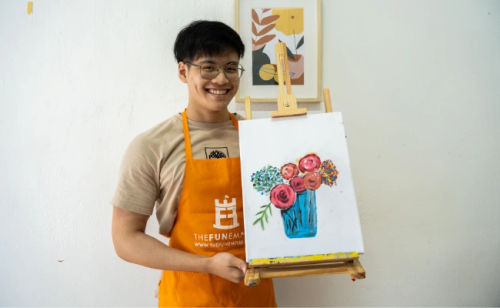
Art Jamming Canvas
Do you want to improve your painting but don’t know how? This article will offer you with six ideas for painting on an Art Jamming canvas. There’s no reason why your next work of art shouldn’t be exceptional now that you’ve seen these instructions! Beginners will definitely gain from these six painting on canvas tips, but even more experienced artists can learn something new. We hope you can apply these tips in your next Art Jamming Workshop!
1. Set the tone with a color that is similar to the overall mood.

It’s simple to set the tone for your work right immediately by using a more general tone first. A bright white canvas, for example, may not be appropriate for a sad or somber painting, but applying a light blue-gray paint layer on a less cheerful surface might help you achieve the desired ambience.
2. Prepare your canvas and materials.

What are some of the most common reasons for wanting to learn how to paint? What is the greatest ways to accomplish so? Is there anything else I should remember when painting, or anything special I should think about? Do I like working with oils, acrylics, watercolor, or pastels in particular as a medium?
There is no such thing as “good” or “bad,” but getting your painting area ready ahead of time can save you some time. All of the paint brushes, palette knives, water, and other painting materials you believe you’ll need should be within reach. The brief amount of time it takes to put this together will make the process much simpler!
3. Begin by painting the negative space.

Painting on canvas is a fantastic method to explore new skills. Underpainting entails drawing the outline of your work in a contrasting color that may be seen only from a distance and adding depth to it.
4. Make sure you’re using the correct hues.

Acrylic paint darkens somewhat while drying, much like other acrylics. Acrylic paint dries somewhat lighter than oil paints, in comparison. As a result, when you use acrylic paint, it will dry somewhat darker than it appears. If necessary, make color adjustments to the final product so that it does not get too dark.
5. Check that you have a safe zone where your canvas may dry.

Even the tiniest works of art may be difficult to handle while wet. Before you start painting, make sure you’ve selected an optimal location for the canvas to dry. Even the lightest brushstroke might result in sticking and difficult cleaning if it’s dried on newsprint or paper. If that isn’t an option, try to use a non-stick medium instead.
6. Don’t be a perfectionist

It’s normal to feel that you have to be perfect when creating a piece of art. However, it all comes to being authentic and allowing yourself to express yourself through painting. Enjoy the process and don’t worry too much about the end product!
Art Jamming Canvas
Painting on canvas isn’t always easy, but with these six pointers, you’ll be well on your way. This lesson will assist novices in painting who aren’t sure where to begin! It may also be a useful resource for seasoned painters hunting for new ways to use their talents. These canvas painting processes are all unique in their own rights, therefore why not give them a go?
Are you interested to learn more about Art Jamming and trying it out? Get in touch with us now! Our specialists would be glad to help you in planning an amazing Art Jamming Singapore experience!
If you’re interested in more articles like this, here are some other lifestyle articles that may appeal to you:
.webp)